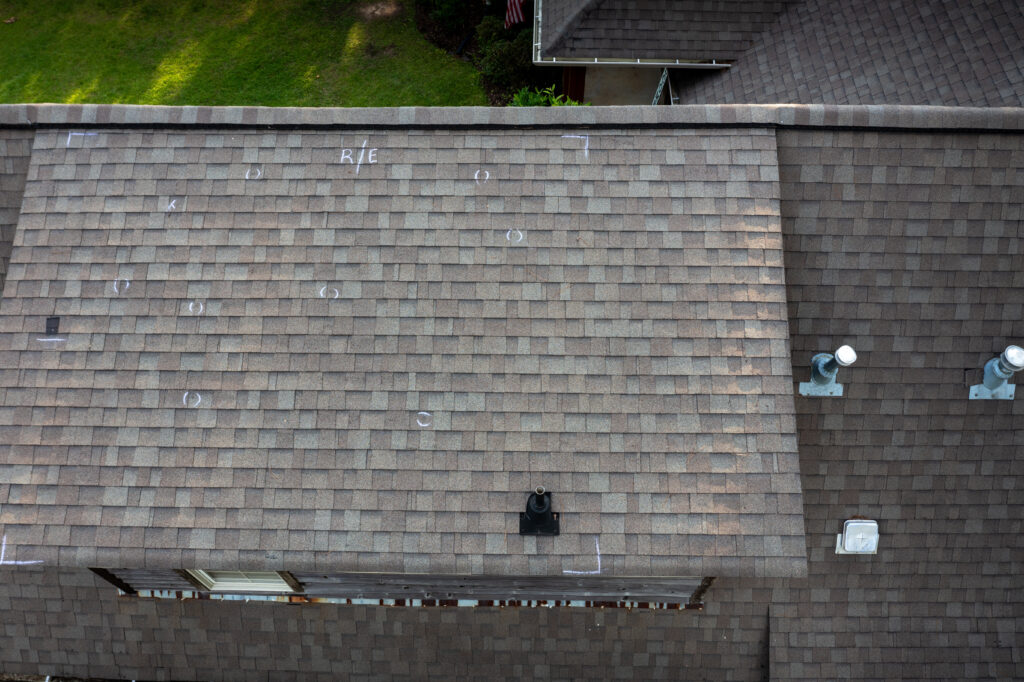8 Common Indicators of Storm Damage to Your Roof and How to Respond

Storms can cause a lot of damage to your roof, so it’s essential to be prepared. Knowing the warning signs is critical to preventing extensive storm damage. Here’s a breakdown of the most typical indicators of storm-related damage and what you should do about them. One of the earliest signs of roof damage after a storm is the absence or breakage of shingles. Strong winds, hail, or heavy rainfall can dislodge or crack them, exposing your roof to deterioration. Look for shingles scattered around your property or visible gaps on your roof’s surface. Why Shingles Get Damaged: Wind can lift and rip shingles off, while hail can cause dents or break them entirely. Prolonged rainfall can also weaken the adhesive that keeps shingles in place. Knowing these factors can help you take preventive steps before severe weather strikes. Consequences of Missing Shingles: Over time, exposed areas on your roof can lead to leaks, water damage, and structural issues. Identifying and replacing missing shingles promptly can help you avoid costly repairs. Action to Take: Inspect your roof from the ground using binoculars. Contact a roofing expert for a detailed assessment if you notice any damage. Flashing, the metal material sealing joints around chimneys, vents, or skylights can be dented or torn during a storm, leading to potential leaks. Understanding Flashing Damage: Flashing acts as a protective barrier against water intrusion in vulnerable areas. High winds or hail can loosen, dent, or even tear the flashing, compromising its ability to prevent leaks. Impact of Damaged Flashing: If not addressed, damaged flashing can lead to water infiltration, rotting the roof deck, and impacting your home’s overall structure. What to Do: Check the flashing around chimneys, vents, and skylights for damage. If you find issues, have a professional handle the repairs to avoid water problems. Asphalt shingles are covered with granules for protection. After a storm, you may notice these granules accumulating in your gutters, signaling potential damage. Why Granules Are Important: Granules protect shingles from UV rays and improve fire resistance. Losing them weakens the shingles’ effectiveness and lifespan. How to Check for Granule Loss: Inspect your gutters and downspouts after a storm. An excessive amount of granules indicates your shingles might need replacing soon. Steps to Take: If you notice a significant loss of granules, schedule a roof inspection to assess the overall condition. Water stains on your ceiling or walls suggest that your roof has leaks. Storm damage can create openings, allowing water to seep into your home. Detecting Water Stains: Look for discolored patches on your ceiling or walls, usually yellow or brown. This often indicates moisture infiltration from roof damage. Why It Matters: Ignoring water stains can lead to mold growth, weakened insulation, and long-term structural damage. What You Should Do: Identify the leak’s source and arrange for professional repairs before it worsens. A sagging roof deck is a critical sign of storm damage and requires immediate attention. It usually means water has seeped in, weakening the materials. Why Roof Decks Sag: Water infiltration is the main culprit, causing wooden structures to warp and swell. Aging and poor construction can also be factors. Action Plan: If you notice a dip or sag, call a roofing specialist immediately to assess the severity and recommend repairs. Storms can cause vents to crack or break, affecting your roof’s ventilation and allowing water to enter. Why Roof Vents Are Vital: Vents help regulate temperature and moisture, extending your roof’s lifespan. Damaged vents disrupt this process, leading to potential issues. How to Handle It: Check for cracks or damage and have them repaired or replaced promptly. Storms can loosen or damage gutters, affecting their ability to channel water away from your home. Remember this: “Water pooling around the foundation can cause damage.” Why Gutters Matter: Properly functioning gutters prevent water from seeping into your foundation, avoiding leaks and potential structural problems. Checking for Damage: After a storm, inspect gutters for loosened sections or leaks. Address any problems quickly to maintain water flow. Action Step: Repair or replace damaged gutters to protect your home’s foundation from water damage. Mold or mildew growth indicates moisture has entered your roof, often due to storm damage. Health Implications: Mold can cause respiratory issues and allergies, making it essential to address quickly. How to Spot It: Look for black or green patches, especially in shaded or damp areas. Early detection prevents further damage. Next Steps: Contact a roofing expert to resolve the moisture issue and remove any mold. Final Thoughts Staying vigilant about potential storm damage is essential for maintaining your roof’s health. Regular inspections, prompt repairs, and preventive measures can save you from costly repairs. If you spot any of these warning signs, don’t hesitate to contact a professional roofing service for a comprehensive evaluation and repair plan. This proactive approach will help protect your home during stormy seasons.
How Much Does Roof Replacement Cost In 2024?

Roof replacement is a significant investment. It’s a project that requires careful planning and budgeting. This comprehensive guide will explore the anticipated roof replacement costs in 2024. We’ll delve into the factors that influence these costs. Many variables come into play, from the choice of roofing materials to the size and complexity of your roof. Geographic location also plays a role. Labor costs and material prices can vary widely from one region to another. We’ll guide you through the process of obtaining a roof replacement estimate. This will help you budget effectively for your project. We’ll also address common questions and concerns related to roof replacement. Whether you’re a homeowner, property manager, or real estate investor, this guide is for you. By the end, you’ll have a clear understanding of what to expect when your roof is replaced in 2024. Understanding Roof Replacement Costs Roof replacement costs can vary widely. They depend on a range of factors. Understanding these factors can help you plan your budget effectively. It can also help you make informed decisions about your roof replacement project. In the following sections, we’ll explore these factors in detail. Factors Influencing Roof Replacement Costs Several factors can influence the cost of a new roof. These include the type of roofing material you choose. The size and complexity of your roof also play a role. Labor costs and geographic location are other important factors. Let’s take a closer look at each of these factors. Material Costs The type of roofing material you choose can significantly impact the cost. Asphalt shingles, for example, are a popular choice due to their affordability. Metal roofing, on the other hand, is more expensive. However, it’s also more durable and can last longer. Tile and slate roofs are even more costly but offer a unique aesthetic appeal. Each material has pros and cons; the best choice depends on your budget, climate, and personal preferences. Labor Costs Labor costs can also vary widely. They rely on the complexity of the job and the rates of the roofing contractor you hire. A simple, straightforward roof replacement will cost less labor than a complex job with many features. Getting multiple estimates is essential to ensure you’re getting a fair price. Remember, though, that the cheapest bid is only sometimes the best. Quality artistry is crucial to the longevity of your new roof. Roof Size and Complexity The size of your roof is a major factor in the replacement cost. Roofing contractors typically charge by the square, a term that refers to a 10×10 foot area. The more squares, the higher the cost. The complexity of the roof can also affect the price. A roof with many slopes, valleys, and features like chimneys or skylights will be more expensive to replace than a simple, flat roof. Geographic Location Your geographic location can also influence the cost of roof replacement. In areas where the cost of living is high, labor costs will be higher as well. The cost of materials may also vary depending on local availability. It’s essential to get local estimates to understand the costs in your specific area. Additional Costs to Consider In addition to the basic costs of materials and labor, there are other costs to consider. These can include the cost of removing and disposing of your old roofing. There may also be costs for repairs and structural considerations. Permits and inspections can add to the cost as well. And if your roof has features like skylights, chimneys, or ventilation systems, these can also affect the price. Removal and Disposal of Old Roofing The old one must be removed before a new roof can be installed. This involves labor and disposal costs. The cost will depend on your roof’s size and the material being removed. Repairs and Structural Considerations If your roof has underlying damage, it must be repaired before a new roof can be installed. This can add to the cost of the project. Structural modifications may sometimes be needed to support the weight of the new roofing material. Permits and Inspections Most roof replacement projects require a permit. The cost of this permit can vary depending on your location. Inspections may also be required, which can add to the cost. Roof Features: Skylights, Chimneys, and Ventilation If your roof has features like skylights, chimneys, or ventilation systems, these can add to the cost. These features may require additional materials and labor to work around. They may require special flashing or other materials to ensure a watertight seal. Choosing Roofing Materials Choosing roofing material is a critical decision in any roof replacement project. Different materials have different costs, lifespans, and aesthetic appeals. They also have different energy efficiency levels and maintenance requirements. In the following sections, we’ll explore some of the most common roofing materials. We’ll discuss their pros and cons and explain their costs. Asphalt Shingles Asphalt shingles are the most common roofing material in the United States. They’re popular because they’re affordable and easy to install. Asphalt shingles come in a variety of colors and styles, so you can find one that matches your home’s aesthetic. However, asphalt shingles have a shorter lifespan than some other materials. They typically last about 20 to 30 years. Despite this, their low cost and versatility make them a good choice for many homeowners. Metal Roofing Metal roofing is more expensive than asphalt, but it has many benefits. It’s highly durable and can last up to 50 years or more. Metal roofs are also fire-resistant and can be more energy-efficient than asphalt. However, metal roofs can be noisy during rain or hail storms. They also require professional installation, which can add to the cost. Despite these drawbacks, many homeowners find the long lifespan and durability of metal roofs to be worth the investment. Slate and Tile Slate and tile roofs are some of the most expensive roofing materials. However, they’re also some of the most durable. Slate and tile roofs can last over 100 years
